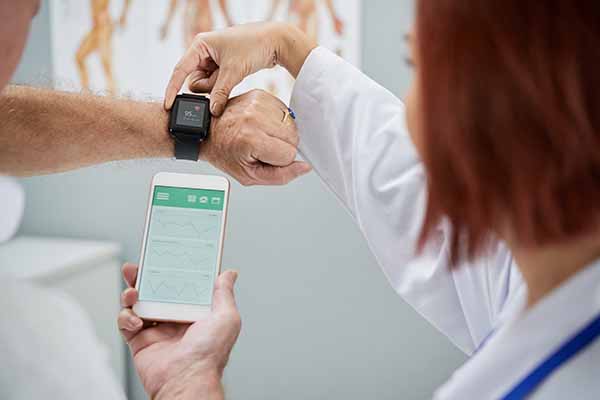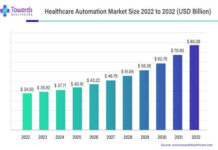New York– According to a new research study by Global Insight Services (GIS), the global wearable healthcare devices market is expected to grow rapidly over the next 10 years to reach a value of more than the US $45.8 billion by 2031.
Wearable healthcare devices allow users to access health-related information on their smart wearable devices include Diagnostic and monitoring devices, vital sign monitoring devices, multiparameter tracker, ECG\heart rate monitors, blood pressure monitors, pulse oximeters, glucose monitoring devices, wrist actigraphs, and polysomnography device among others are the most commonly used wearable devices to tracking the health related condition.
Wearable Health Devices Market: Key Trends and Drivers
Increasing prevalence of various chronic diseases including diabetes and cardiovascular disorders upsurge the demand for wearable medical devices. The use of continuous monitoring equipment has expanded along with the prevalence of these disorders. Additionally, during the past few years, technology advancements that enable user mobility and connectivity have boosted product sales. This will provide the healthcare sector with innovative methods for the management of patients and diseases. Additionally, the ability of wearable technologies to lower healthcare costs while increasing patient care quality will promote market expansion.
Furthermore, these devices have provided effective real-time monitoring solutions to patients with chronic diseases during the period of movement restrictions and increased infection risk in facilities. Additionally, the market demand has been bolstered by the capabilities of fitness trackers, temperature monitors, and respiratory monitors to track and monitor blood oxygen levels and body temperature.
Wearable Healthcare Devices Market: Restraints & Challenges
Rising concerns regarding data sharing and security restrains the market growth to some extent. Manufacturers of therapeutic devices in the U.S. and Europe confront significant difficulties from patent reforms and patent trolls. Businesses known as “patent trolls” purchase patents in order to sue businesses for royalties for allegedly violating the terms of patents held by “patent assertion entities” or “non-practicing entities” (NPEs). In 2013, patent trolls made their entrance into the medical technology sector by bringing multiple claims of infringement against manufacturers of medical devices. Companies can secure the monetary and legal rewards of successfully filed patents and reduce potential losses brought on by patent trolls by taking careful steps to protect mobile medical technology advances through patents. Success in the quickly developing clinical-grade wearables sector depends on protecting patents.
Wearable Healthcare Devices Market Report Findings
The charge-coupled device detectors segment is likely to hold a dominant wearable healthcare devices market share and grow at a substantial CAGR during the forecast period.
Based on devices, the global wearable healthcare devices market has been bifurcated into activity/fitness monitors, diabetes devices, cardiac monitors, neurological monitors, respiratory monitors, body & temperature monitors, hearing aids. In 2021, the cardiac monitors segment was the significant revenue generator and it is anticipated to grow at the fastest growth rate during the study period. This is attributed to the increasing number of cardiac disorders coupled with rising influx of therapeutic devices. Moreover, a strong pipeline of cardiac monitoring devices such as intelligent asthma management products, wearable pain reliever devices, and insulin management devices is anticipated to assist market growth.
The dental segment is anticipated to hold a majority of the wearable healthcare devices market size throughout the study period.
Based on application, the market is fragmented into cardiac health, obesity control, diabetes care, fitness monitoring, sleep tracking and others. In 2021, the diabetes care segment generated the highest revenue, and it is expected to exhibit the highest growth rate during the study period. The rising number of people suffering from diabetes, and growing need for rapid and accurate diagnosis are the other major factors drive the dental segment growth. Also, changing lifestyle pattern and rising geriatric population that more prone to illness all this factors increased the cases of diabetes thereby augmenting the demand for diabetic care. Hence aforementioned factors fuel the market growth.
The imaging center segment is anticipated to hold a majority of the wearble healthcare devices market size throughout the study period.
Based on end-use, it is segmented into home healthcare, remote patient monitoring, fitness and sports and others. The Fitness and sports segment is likely to dominate the wearable healthcare devices market during the forecast period. The growing adoption of fitness monitoring devices in sports centers coupled with presence of advanced advanced monitoring devices are boosting the growth of the market. Moreover, robust penetration of 3G and 4G networks for uninterrupted healthcare services is driving the growth of this segment.
The Asia-Pacific region is estimated to exhibit the highest growth rate during the wearable healthcare devices market forecast period.
Region-wise, it is studied across North America, Europe, Asia Pacific, and the Rest of the World. North America accounts for the largest market share in the wearable healthcare devices market and is forecasted to register the fastest CAGR from 2022 to 2031. Factors such as rapid development geriatric population along with development in the healthcare infrastructure, along with the growing demand for portable monitoring devices in the emerging economies are anticipated to propel the wearable healthcare devices market growth. Further, rising incidence of chronic disorders coupled with increasing number of hospitals in the Asia-Pacific, especially in China, is driving the growth of the market. Throughout the study period, prominent players are anticipated to witness remunerative opportunities in several nation.
Have a question for our analyst:
Competitive Landscape
The global wearable healthcare devices market report includes players such as Koninklijke Philips N.V. (Netherlands), Apple Inc. (US), GE Healthcare (US), Fitbit Inc. (US), Abbott Laboratories (US), OMRON Corporation (Japan), Garmin Ltd. (US), Dexcom Inc. (US), Masimo Corporation (US), Medtronic PLC (Ireland), BioTelemetry Inc. (US), Preventice Solutions Inc. (US), iRhythm Technologies Inc. (US), Contec Medical Systems Co. Ltd. (China), MediBioSense Ltd. (UK), VitalConnect (US), and Cyrcadia Health Inc. (US) among others
In addition, major vendors are focused on developing smarter technologies for wearable healthcare devices. For instance, in 2019, Omron Healthcare launched HealthGuide, which looks like a typical smart watch but is incorporated with features to monitor blood pressure. Thus, all the above-mentioned factors are responsible for the growth of the market.
Recent Developments in the Wearable Healthcare Devices Market:
- In June 2020, Koninklijke Philips N.V. (Netherlands) Launched fetal and maternal pods and patches for continuous, non-invasive monitoring of maternal heart rate, fetal heart rate, and uterine activity with a single-use, 48-hour, disposable electrode patch.
- In April 2021 Fitbit, Inc. (US) Launched Fitbit Luxe.
- In February 2020, the Edinburgh, Scotland-based Company received clearance for the AI-enabled device in monitoring patients while in the hospital, but this recent approval means it can now be used between doctor visits at home too.
- In March 2020, Fitbit, Inc. (US) partnered with FibriCheck to deliver a CE-marked Heart Health Detection App to Fitbit smartwatch users in Europe.
Wearable Healthcare Devices Market Report Coverage
- The report offers a comprehensive quantitative as well as qualitative analysis of the current global wearable healthcare devices market outlook and estimations from 2021 to 2031, which helps to recognize the prevalent opportunities.
- A thorough analysis of market trends and restraints is provided.
- Region-wise, as well as country-wise conditions, are broadly evaluated in this report.
- The forecasts in this report are made by examining the recent trends along with future wearable healthcare devices market potential from 2021 to 2031 in terms of revenue.
- Porter’s five forces analysis, SWOT analysis, COVID-19 impact analysis, Russia-Ukraine war impact, and PESTLE analysis of the wearable healthcare devices market are also analyzed.
- Major players in the market are profiled in this report and their key developmental strategies are studied in detail. This will provide an insight into the competitive landscape of the global wearable healthcare devices industry.
Read More – https://www.globalinsightservices.com/reports/wearable-healthcare-devices-market/















